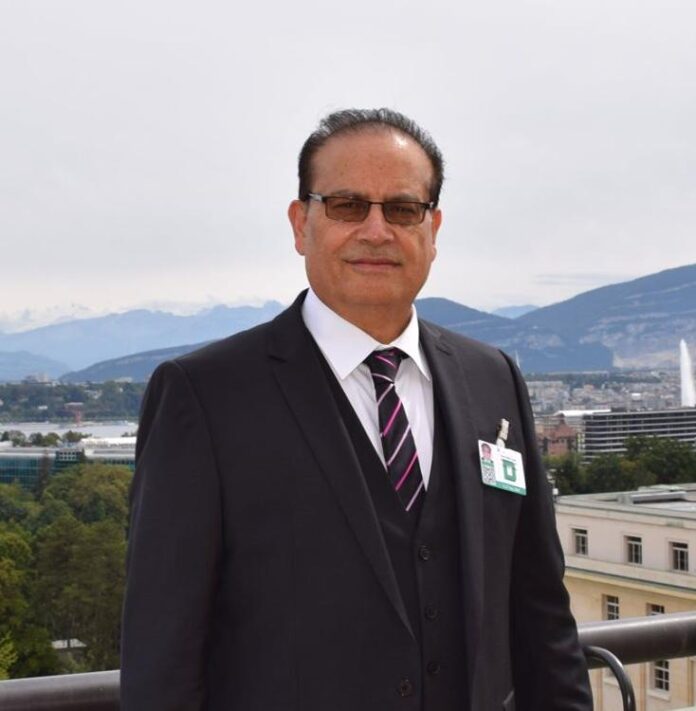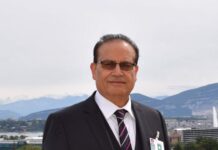By: Qamar Bashir
Macomb, Detroit, Michigan
After the nationwide abhorrent terrorist attacks in the USA, President-elect Donald Trump painted a grim picture of the country. He stated, “Our country is a disaster, a laughingstock all over the world! This is what happens when you have OPEN BORDERS, with weak, ineffective, and virtually nonexistent leadership.”
He blamed the United States Department of Justice and the FBI for their failure to ensure the safety and security of the American people, criticizing them for not fulfilling their responsibilities of enforcing U.S. laws, overseeing law enforcement, and representing the nation in legal matters, as well as administering justice at a federal level. Trump then added a third culprit to complete the triangle: the “Democrats.” He accused the Democrats of incompetence and corruption, claiming they spent all their time unlawfully attacking their political opponents instead of protecting Americans from violent elements that, according to him, have infiltrated every aspect of the government and the nation itself. He further stated that the Democrats should be ashamed of themselves for allowing such a situation to arise in the country.
Trump warned the CIA to intervene immediately, saying, “NOW, before it is too late.” He concluded his statement by declaring that the USA is breaking down, suffering from “a violent erosion of safety, national security, and democracy” nationwide.
He asserted that only strength and powerful leadership could stop this decline, ending with a pledge: “See you on January 20th. MAKE AMERICA GREAT AGAIN!”
The big question remains: how does Trump plan to make America great again? In his victory speech after his historic 2024 election win, Trump outlined his ambitious “Agenda 47.” While his policies appear promising on the surface, they carry both anticipated and unforeseen repercussions, not only for the U.S. but also for the rest of the world.
Trump’s top priority is improving the U.S. economy, recognizing that in today’s interconnected world, no country can act alone without risking adverse consequences. He pledged to impose universal tariffs of 10%-20% to protect U.S. industries and address trade imbalances, particularly with China, which accounted for $537 billion in imports to the U.S. in 2022. Tariffs could boost domestic manufacturing by reducing foreign competition but may raise consumer prices, disrupt supply chains, and exacerbate inflation.
On energy policy, Trump pledged to achieve energy independence by rolling back petroleum production regulations, exiting the Paris Agreement, and expediting oil infrastructure projects. This could drive economic growth, create jobs, and enhance energy security, strengthening the U.S. as a major energy exporter. However, it may increase carbon emissions, environmental harm, and weaken global climate leadership.
Trump’s tax reforms include extending the 2017 Tax Cuts and Jobs Act, eliminating federal taxes on tips and Social Security income, and making car loan interest fully tax-deductible. These measures aim to boost disposable income, support retirees, and stimulate industries like automotive and hospitality. However, they risk widening the federal deficit, which already exceeds $33 trillion, without corresponding spending cuts or revenue increases.
On immigration, Trump pledged mass deportations of undocumented immigrants, completing the Mexico border wall, reinstating the “Remain in Mexico” policy, and ending birthright citizenship for children of undocumented immigrants. These measures aim to deter illegal immigration but could cause labor shortages, legal challenges under the 14th Amendment, humanitarian concerns, and strained U.S.-Mexico relations.
Trump’s foreign policy priorities include resolving the Ukraine-Russia conflict within 24 hours, reducing involvement in “endless wars,” prioritizing U.S. interests in trade agreements, and pressuring NATO allies to increase defense spending. While these policies could strengthen military readiness and reduce long-term entanglements, critics warn they may alienate allies, destabilize alliances, and oversimplify complex geopolitical issues.
Trump’s foreign policy on Palestine, Syria, and Iran emphasizes a mix of disengagement and assertive measures. He aims to resolve the Gaza conflict and weaken Hamas by targeting Iran’s support network. In Syria, he opposes U.S. military involvement, maintaining it is not America’s fight, even as opposition forces gain ground. Toward Iran, he is likely to revive his “maximum pressure” campaign with stringent sanctions to curb its nuclear ambitions and regional influence. The upside is that it could reduce U.S. military entanglements, weaken adversarial groups like Hamas, and apply economic and diplomatic pressure to contain Iran’s influence. The downside is that the potential destabilization in the region, humanitarian crises from inaction in Syria, and the risk of further isolating the U.S. from diplomatic solutions, potentially exacerbating tensions without resolving underlying conflicts.
He pledged to obliterate the Deep State, downsize bureaucracy, and cut expenditure. The upside is that reducing bureaucratic red tape and government spending could streamline operations, enhance efficiency, and return power to citizens by limiting overreach. Cutting unnecessary expenditures may lower the national debt and improve fiscal responsibility. The downside is that drastic downsizing could lead to the loss of experienced personnel, reduced oversight, and disruption of essential services. Efforts to dismantle the “Deep State” might politicize government institutions, erode trust in public administration, and create instability in critical governance functions.
His other domestic policies are even more sweeping. He pledged a patriotic curriculum and school choice to promote national unity and empower parents with educational options. The downside is that centralized credentialing and removing federal oversight may create disparities in educational quality across states.
He promised harsh penalties for serious crimes and structured facilities for homelessness could improve public safety and order. The downside is that these measures may oversimplify complex issues, neglect rehabilitation, and raise ethical concerns.
He pledges to improve infrastructure and Urban Development by creating “Freedom Cities” and cultural initiatives to spur innovation, economic growth, and national pride. The downside is that these projects may face high costs, feasibility challenges, and potential public resistance to large-scale federal developments.
When America sneezes, the world catches a cold. The election of Donald Trump has sparked both hope and nervousness within the American nation and across the globe. The entire world waits with bated breath, fingers crossed, to see whether his promises will make America great again or lead to unforeseen consequences. Americans and global observers alike are anxiously anticipating the rollercoaster ride under Trump’s unpredictable, mercurial, and impulsive leadership. This time, he is flanked by figures like Elon Musk, Vivek Ramaswamy, and Kash Patel—business leaders and technocrats with proven records of success and remarkable achievements. Let us hope his presidency not only revitalizes the United States but also creates a better world for everyone.
By: Qamar Bashir
Press Secretary to the President (Rtd)
Former Press Minister at Embassy of Pakistan to France
Former MD, SRBC

















